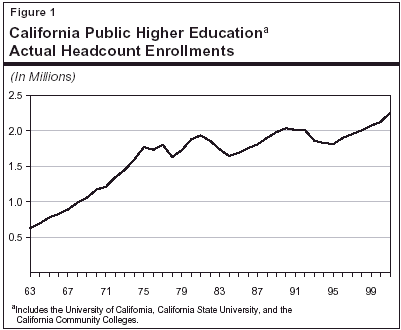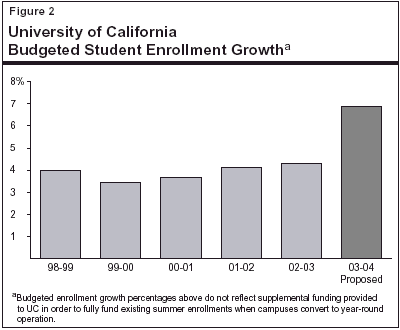Legislative Analyst's OfficeAnalysis of the 2003-04 Budget Bill |
For the past ten years, the state's public higher education segments have experienced moderate sustained enrollment growth. The Governor's budget proposes $268.1 million to fund enrollment growth at the University of California (UC) and at the California State University (CSU) of 6.9 percent and 7.1 percent, respectively. The proposed budget also assumes a net decline of enrollment at the California Community Colleges (CCC) of 5.7 percent. In this section, we (1) provide an historical perspective of enrollments at the three segments and (2) analyze the Governor's proposed levels of enrollment growth for UC and CSU in 2003-04 and recommend an alternative to those levels. (We discuss enrollment at CCC in the "California Community Colleges" section of this chapter.)
In 2001, approximately 2.3 million students ("headcount enrollments") were enrolled either full-time or part-time at CCC, CSU, and UC. This is equal to roughly 1.6 million full-time-equivalent (FTE) students. (We describe the differences between headcount and FTE in the accompanying text box on page 28.) Figure 1 summarizes actual headcount enrollments from 1963 to 2001 for the state's public colleges and universities. The figure shows that enrollment grew rapidly through 1975, fluctuated up and down over the next two decades, and has grown steadily since 1995. Total enrollment in 2001 was 354,712 (or about 19 percent) more students than in 1990.
The budget requests a total of $268.1 million in General Fund support to increase budgeted enrollment at UC and CSU. The $268.1 million total consists of:
In contrast to the Governor's proposal for the public universities, the budget actually reduces funded enrollment at CCC by 5.7 percent. (Although $116 million is nominally provided to accommodate new enrollment, this is more than offset by funding redirections to account for attrition due to fee increases.) As a result, the budget provides funding for about 62,200 fewer FTE students in 2003-04.

As indicated above, the Governor's enrollment growth proposals for the two university systems and the community colleges vary considerably—roughly 7 percent enrollment growth for UC and CSU compared to a 5.7 percent decline for CCC. Some variation in funding for the segments is to be expected. The segments have different missions and serve somewhat different student populations, and so it is not necessary or even desirable to fund enrollment growth at all three segments equally. However, the segments do function as parts of an integrated higher education system, and thus have interactive effects. For example, price-sensitive students may choose to avoid the higher cost at UC and CSU by completing their lower-division coursework at CCC and then transferring to a four-year institution in their junior year.
Overall, we cannot find a basis for assuming, in a time of fee increases, such a large increase in enrollment at the higher-cost institutions while assuming such a large decrease in enrollment at the lower-cost institutions. In the balance of this writeup we focus on enrollment growth funding at UC and CSU. Enrollment growth funding at CCC, which is subject to the minimum funding guarantee of Proposition 98, is discussed separately in the "California Community Colleges" section of this chapter. Our recommendations in these two writeups call for reducing the enrollment funding gap between the state's universities and its community colleges.
FTE Versus Headcount EnrollmentIn this analysis, we generally refer to FTE students, rather than headcount enrollments. Headcounts refer to the number of individual students attending college whether they attend on a part-time or full-time basis. In contrast, the FTE measure converts part-time student attendance into the equivalent full-time basis. For example, two half-time students would be represented as one FTE student. In 2001, one average headcount enrollment equaled 0.97 FTE at UC, 0.81 FTE at CSU, and 0.65 at CCC. For UC and CSU, FTE per headcount enrollment seldom varies by more than a few percentage points. Over the past 30 years, the number of FTE per headcount enrollment in the community colleges has varied from a high of 0.65 (2001) to a low of 0.55 (1990). The ratio varies more for CCC because they serve a much higher percentage of part-time students. Headcount measures are typically used by the Department of Finance and the California Postsecondary Education Commission to make enrollment projections for future years. On the other hand, FTE measures better reflect the operating and capital costs required to serve students and is the measure the Legislature uses for state budgeting purposes. |
Highest Budgeted Enrollment Growth in Recent History. Figures 2 and 3 show UC and CSU's budgeted enrollment growth for each of the past five years and proposed enrollment growth for next year. From 1998-99 through 2002-03, UC and CSU received an average of about 4 percent for annual budgeted enrollment growth. As indicated in the figures, the Governor's budget proposes enrollment growth rates—6.9 percent at UC and 7.1 percent at CSU—that far exceed recent practice. For example, the state provided funding in the current year for increased enrollments of 4.3 percent at UC and 5 percent at CSU. In fact, based on historical data from UC, the proposed 6.9 percent enrollment growth for the system would be the highest in 25 years. At the time of this analysis, CSU was unable to provide data on budgeted enrollment growth prior to 1982-83. However, available data indicate that 7.1 percent would be the highest in at least the past 20 years.


Budgeted Enrollment Exceeds Demographic Projections. As Figure 4 shows, the budgeted enrollment growth rates proposed by the Governor are significantly higher than growth rates projected by the Demographics Unit in the Department of Finance (DOF) and the California Postsecondary Education Committee (CPEC). For example, the proposed enrollment growth of 6.9 percent for UC is about three times CPEC's estimate of 2.26 percent, and almost twice the administration's own projection of 3.63 percent. The DOF and CPEC developed their projections using demographically based projections of growth in the number of high school graduates and in the adult population. In developing their baseline projections, both DOF and CPEC assumed that college-participation rates would generally increase or remain constant for high school graduates and for many adult age groups.
Moreover, we note that the Governor's budgeted enrollment growth rates for UC and CSU far exceed demographic projections regarding the state's college-age population. The state's 18-to-24-year old population is expected to grow by only 1.5 percent in 2003-04. This means that the proposed enrollment growth at UC and CSU is more than four times the estimated increase in the prime college-going population age group.
UC and CSU Requested Lower Enrollment Growth. Last fall, the UC Board of Regents and the CSU Board of Trustees approved 2003-04 budgets for their respective segments. These budgets—which were subsequently submitted to the Governor for consideration—included funding for enrollment growth rates of 4.2 percent at UC and 5 percent at CSU. The Governor's proposed enrollment growth rates are considerably higher.
|
Figure 4 Proposed Versus Projected 2003-04 Enrollment Growth Rates |
|||
|
|
DOFa |
CPECb |
Governor's Budget |
|
UC |
3.63% |
2.26% |
6.9% |
|
CSU |
4.03 |
2.51 |
7.1 |
|
a Department of Finance, 2002 Projection Series. |
|||
|
b California Postsecondary Education Commission, 2000 Projection Series. |
|||
Over the past several years, the Legislature has expressed considerable interest in preserving access to the state's public higher education segments. The administration argues that a large increase in budgeted enrollment is necessary to ensure such access when fees increase. We disagree. Increasing enrollment funding does nothing to address financial barriers to higher education. Nor does it increase the number of students who qualify for admission, or influence the enrollment decisions of admitted applicants. We believe access is best promoted by reducing financial barriers (such as those related to the cost of attendance) and improving academic preparation—not by expanding course sections at UC and CSU. We note that the budget provides substantially more funding than necessary to cover projected increases in the number of students that typically enroll at the segments. Such funds could be better spent on initiatives that would increase opportunities for students at the state's universities and colleges. In a later section, we recommend an expansion of student financial aid in the state's student-centered Cal Grant program.
The budget enrollment levels funded in each year's budget are targets for which funding is provided. Because the number of eligible students enrolling at the segments cannot be predicted with complete accuracy, in any given year UC and CSU typically serve slightly more or less FTE students than budgeted. Recent practice has been for the segments to internally redirect resources to accommodate any "overenrollment" in a given year.
The Governor's 2003-04 Budget proposal departs from recent practice in that it provides a separate, additional amount on top of the regular growth allocation to fund prior overenrollment. This special allotment is $45 million each for UC and CSU. We can find no justification for the state to alter how it budgets higher education enrollments, for the following reasons:
We recommend the Legislature delete $114.9 million from the $268.1 million requested in the budget for enrollment growth at the University of California and the California State University, because budgeted growth rates significantly exceed demographic projections. Our proposal would leave each segment with adequate funding to increase budgeted enrollment by 4 percent. (Reduce Item 6440-001-0001 by $48.7 million and Item 6610-001-0001 by $66.2 million.)
As noted in the above analysis, we find no justification for the amount of enrollment growth funding proposed in the Governor's budget. We recommend therefore that the Legislature instead provide both UC and CSU funding for enrollment growth at a rate of 4 percent. Accordingly, we recommend a total General Fund reduction of $114.9 million, including $48.7 million from UC and $66.2 million from CSU.
Under our proposal, UC and CSU would receive budgeted enrollment growth at or slightly above the rates projected by DOF and CPEC. We believe that 4 percent enrollment growth allows the segments to accommodate enrollment growth due to increases in population and college participation. Accordingly, we recommend that the Legislature reject the Governor's proposal to increase funding for students already enrolled at UC and CSU.